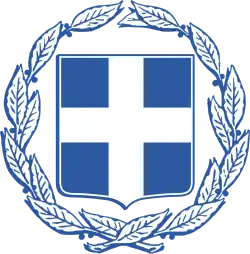Greek Australians
Greek Australians (Greek: Ελληνοαυστραλοί, romanized: Ellinoafstralií) are Australians of Greek ancestry. Greek Australians are one of the largest groups within the global Greek diaspora. As per the 2021 census, 424,750 people stated that they had Greek ancestry (whether alone or in combination with another ancestry), comprising 1.7% of the Australian population.[1] At the 2021 census, 92,314 Australian residents were born in Greece.[1]
Ελληνοαυστραλοί | |
|---|---|
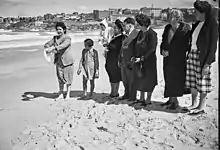 Greek Australian christening party, at Bondi Beach 1946. | |
| Total population | |
| 424,750 by ancestry (2021 census)[1] (1.7% of the Australian population)[1] 92,314 born in Greece[1] | |
| Regions with significant populations | |
| Melbourne, Sydney, Adelaide, Brisbane, Perth | |
| Languages | |
| Australian English · Greek · Greco-Australian | |
| Religion | |
| Greek Orthodoxy | |
| Related ethnic groups | |
| Cypriot Australians · Greek New Zealanders · Greek diaspora |
Greek immigration to Australia has been one of the largest migratory flows in the history of Australia, especially after World War II and the Greek Civil War. The flow of migrants from Greece increased slightly in 2015 due to the economic crisis in Greece,[2] with Australia as one of the main destinations for departing Greeks, mainly to Melbourne, where the Greek Australian community is most deeply established.[3]
88% of Greek Australians speak Greek and 91% are Christians and members of the Greek Orthodox Church.[4]
Australia and Greece have a close bilateral relationship based on historical ties and the rich contribution of Greek Australians to Australian society. In 2019, the export of Australian services to Greece was valued at $92 million, while services imports from Greece totalled $750 million. Australia's stock of investment in Greece in 2019 totalled $481 million, while investment in Australia from Greece was $192 million.[5]
History
| Part of a series on |
| Greeks |
|---|
.svg.png.webp) |
|
(Ancient Byzantine Ottoman) |
Early Greek immigration
Greek immigration to Australia began in the early colonial period in the 19th century. The first known Greeks arrived in 1829.[6] These Greeks were seven sailors, convicted of piracy by a British naval court, and were sentenced to transportation to New South Wales. Though they were eventually pardoned, two of those seven Greeks stayed and settled in the country. One settled on the Monaro Plains in Southern New South Wales and one at Picton near Sydney. Their names were Ghikas Bulgaris known as Jigger Bulgari, and Andonis Manolis. Jigger Bulgari married an Irish woman, and they had many children. Jigger was buried at Nimmitabel Pioneer Cemetery. The Hellenic Club of Canberra laid a commemorative marble plaque over his resting place around 2000. Andonis Manolis' grave is in the old cemetery at Mittagong. The first known free Greek migrant to Australia was Katerina Georgia Plessos (1809–1907),[7] who arrived in Sydney with her husband Major James Crummer in 1835. They married in 1827 on the island of Kalamos where Crummer, the island's commandant, met the young refugee from the Greek independence wars. In her youth, she must have been one of the last living people to speak to Lord Byron. They lived in Sydney, Newcastle and Port Macquarie. They had 11 children.[8] The first wave of free Hellenic migrants commenced in the 1850s, and continued through the end of the 19th century, prompted in part by the recent discovery of gold in the country.[9]
20th century Greek immigration
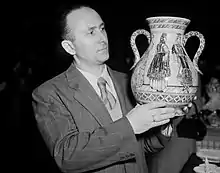
From the last decade of the 19th century until World War I, the number of Greeks immigrating to Australia increased steadily and Hellenic communities were reasonably well established in Melbourne and Sydney at this time. The Greek language press began in Australia and in 1913, Australia had the first Greek weekly newspaper called Afstralia that was published in Melbourne.[10]
It is noted that the first major flow of Greek immigrants to Australia began in the mid 1920s, where many Greek people from Kastellorizo migrated to Australia to escape the Ottoman repression. Numerous of these people from Greece's easternmost island spent time in Egypt's second largest city, Alexandria, before being offered migration to Australia by British authorities.
After the changes in Greece from the mid 1970s, including the fall of the Papadopoulos regime in 1974 and the formal inclusion of Greece into the European Union, Greek immigration to Australia has slowed since the 1971 peak of 160,200 arrivals. Within Australia, the Greek immigrants have been "extremely well organised socially and politically", with approximately 600 Greek organisations in the country by 1973, and immigrants have strived to maintain their faith and cultural identity.[11]
By comparison, the Greek Cypriot community in Australia doubled following the Invasion of Cyprus by Turkey following a campaign of ethnic cleansing in 1974. [12]
21st century Greek immigration
.jpg.webp)
Since the year 2000, Greek immigration to Australia has slowed down. As the economic crisis in Greece grew, the opportunities for temporary resident Greek Australians abroad were limited.
In the early 2010s, there has been an increase of Greek immigration flows to Australia due to unemployment, among other issues, because of the economic crisis in Greece. This has led to the return of many Greek Australians which had gone to Greece before the crisis and also the arrival of newcomers from Greece, who have been received by the large Greek Australian community, mainly in Melbourne.[13]
Demographics
At the 2021 census, 424,750 people stated that they had Greek ancestry (whether alone or in combination with another ancestry), comprising 1.7% of the Australian population.[1] At the 2021 census, 92,314 Australian residents were born in Greece.[1]
The largest concentration of Greek Australians is in the state of Victoria, which is often regarded as the heartland of the Greek Australian community. Victoria's capital Melbourne has the largest Greek Australian community in Australia.
The 2021 census showed that the following states had the largest numbers of people nominating Greek ancestry: Victoria (181,184), New South Wales (141,627), South Australia (40,704), Queensland (32,702), Western Australia (16,117).[14]
One study investigating the 54 most common ethnic groups in Australia found that Greek Australians had the lowest rate of intermarriage (marrying outside their ethnicity) than every other ethnicity in the first, second and third generations.[15]
Culture
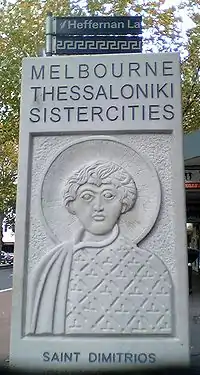
Religion
According to census data released by the Australian Bureau of Statistics in 2016, 91.4% of Australians with Greek ancestry are Christian, mainly Eastern Orthodox, however minorities who belong to different Christian denominations like Catholics, Jehovah's Witnesses and Pentecostals also exist. Together, these other denominations make up 0.4% of the Greek Australian population. 5.6% identified as spiritual, secular or irreligious, and 2.6% did not answer the census question on religion.[16] Greek Australians are predominantly Greek Orthodox.[16] The largest religious body of Greek Orthodox Australians is the Greek Orthodox Archdiocese of Australia, with its headquarters at the Cathedral of The Annunciation of Our Lady in the inner Sydney suburb of Redfern.
Greek language
In 2016, the Greek language was spoken at home by 237,588 Australian residents, a 5.8% decrease from the 2011 census data. Greek is the seventh most commonly spoken language in Australia after English, Mandarin, Arabic, Cantonese, Vietnamese and Italian.[17] The remainder of the ethnic Greek population in Australia mainly use English as their first language. Most Greek Australians speak the Greco-Australian dialect. Greco-Australian is an Australian-based dialect of Greek that is spoken by the Greek diaspora of Australia, including Greek immigrants living in Australia and Australians of Greek descent.[18]
Media
The Greek language press began in Australia in 1913 when the first Greek weekly newspaper was published in Melbourne. In South Australia, the local Greek community published a short-lived newspaper called Okeanis (Oceania), around 1914 before it moved to Sydney.[19] On 16 November 1926, George Marsellos and John Stilson published a broadsheet under the name Panellenios Keryx (Panhellenic Herald or The Greek Herald), becoming the second national Greek newspaper in Australia.[20] In 1935 and 1936 a third newspaper, Pharos (Lighthouse), was published, and a number of short-lived titles were issued in the late 1960s, with the longest of these being Tachydromos (Mailman), founded in September 1968.[19] In 1957, Hellenic/Greek language newspaper Neos Kosmos was founded by Dimitri Gogos, Bill Stefanou and Alekos Doukas, the latter also being an exceptionally well known author. Since 1994, a publication called Paroikiako Vema (Steps in the adopted Country) and printed in Renmark, has served the Greek community in rural South Australia.[21]
Multicultural broadcaster SBS (Special Broadcasting Service) airs a Greek-language radio program every afternoon from 4 PM to 6 PM. The program features news, current affairs, music, interviews, and a talkback segment, where listeners can dial into the program from 5:30 PM onwards and express their opinion on a topic being focused on. Additionally, SBS also airs Greek public broadcaster ERT's Eidiseis news program every morning as part of their WorldWatch programming block.
Notable individuals
Academic
- Nikos Athanasou – Professor of Musculoskeletal Pathology at Oxford University and Greek-Australian novelist.[22]
- Nick (Νικήτας) Birbilis – Professor of Engineering at the Australian National University.
- Adrian David Cheok – Professor of Pervasive Computing at City University London & Director of the Mixed Reality Lab
- Nicholas Doumanis – Assoc. Professor of History, at the University of New South Wales
- Nikolas Kompridis – Professorial Fellow at the University of Western Sydney in the School of Humanities & Communication Arts
- Christos Pantelis – Professor of Psychiatry, University of Melbourne
- Maria Skyllas-Kazacos – Emeritus Professor at the University of New South Wales, chemical engineer best known for her pioneering work of the vanadium redox battery
- John Tasioulas – Director of Institute for Ethics in AI and Professor of Ethics and Legal Philosophy at University of Oxford and first Greek-Australian Rhodes Scholar
Art and design
- Con Chrisoulis – comic book creator
- Nonda Katsalidis – architect
- Marc Newson – industrial designer
- Polixeni Papapetrou – artist
- Paul Pholeros – architect
- Tony Rafty – caricaturist
- Stelarc (Stelios Arkadiou) – artist
- Christos Tsiolkas – writer
- Michael Zavros – artist/painter
Business
- Harry Katsiabanis – founder of TaxiLink and StorageX
- Mark Bouris – managing director of Wizard
- George Calombaris – chef, former judge MasterChef Australia
- Con Constantine – former chairman, Newcastle United Jets
- Andrew Demetriou – chief executive, Australian Football League
.jpg.webp)
- Antony J. J. Lucas – businessman noted for his philanthropic activities
- Marinos Lucas – businessman, theatre company operator
- Andrew N. Liveris – CEO of Dow Chemical Company
- Kostas Makris – the richest Greek in Australia (in the top 30 of the richest residents in Australia)
- Nick Pappas – chairman, South Sydney Rabbitohs
- Nicholas Paspaley Senior and Paspaley family (Paspalis) – Paspaley dominate the pearling industry; large property holdings in Darwin CBD and properties in Sydney
- George Peponis – chairman, Canterbury Bulldogs
- Geoff Polites – chief executive officer of Australian Jaguar Land RoverFPV President / Tickford managing director
- Nick Politis – car retailer and chairman of the Sydney Roosters rugby league club
- James Samios – Hon. MBE Museum of Contemporary Art, Circular Quay, Sydney
- Peter V'landys – chairman of the Australian Rugby League Commission
Fashion
- Christopher Chronis – fashion designer
- Napoleon Perdis – make-up artist
- Alex Perry – fashion designer
.jpg.webp)

Film, theatre, and television
- Peter Andrikidis – director and producer, Underbelly, G.P.
- Alex Andreas – actor, Fat Tony & Co.
- Alex Blias – actor, Home and Away
- Elena Carapetis – actress, Heartbreak High
- Gia Carides – actress, Austin Powers: International Man of Mystery, Brilliant Lies, My Big Fat Greek Wedding, Strictly Ballroom
- Zoe Carides – actress, Death in Brunswick, G.P.
- Wayne Coles-Janess – director and producer
- Chantal Contouri – actress, Number 96
- Mary Coustas – comedian and actress
- Alex Dimitriades – actor, The Heartbreak Kid, Heartbreak High, Head On, The Slap
- Rebekah Elmaloglou – actress, Home and Away and Neighbours
- Sebastian Elmaloglou – actor, Home and Away, brother of Rebekah
- Damien Fotiou – actor, Kangaroo Jack, Head On
- Nick Giannopoulos – actor, The Wog Boy, Acropolis Now and director
- Diana Glenn – actress
- George Houvardas – actor, Packed to the Rafters
- Hugh Jackman – actor, Paperback Hero, Australia, Logan, The Greatest Showman[23]
- George Kapiniaris – actor, Acropolis Now and comedian
- Peter Kelamis – comedian
- Costas Kilias – actor
- Ana Kokkinos – director, The Secret Life of Us, Head On
- Katerina Kotsonis - actress, Neighbours
- Nico Lathouris – actor
- Costas Mandylor – actor, Saw, Picket Fences
- Louis Mandylor – actor, My Big Fat Greek Wedding
- Lex Marinos – actor, Kingswood Country, director, writer and broadcaster
- Harry Michaels – actor, Number 96, producer, Aerobics Oz Style, and director, Sports TV
- Bill Miller – director and producer
- George Miller – Academy Award-winning director and producer, Babe, Happy Feet, Mad Max: Fury Road

- Ada Nicodemou – actress, Home and Away, Heartbreak High, Police Rescue
- Tony Nikolakopoulos – actor and director
- Socratis Otto – actor, known for television series Young Lions, and Wentworth
- Alex Papps – actor, Home and Away, The Henderson Kids and presenter, Play School
- Thaao Penghlis – actor, Days of Our Lives, General Hospital, Santa Barbara (TV series)
- Alex Proyas – director, I, Robot, Dark City, The Crow, Knowing
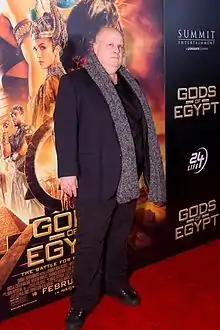
- Jordan Raskopoulos – comedian and singer
- Steen Raskopoulos – actor and comedian
- Gina Riley – actress, Kath & Kim, comedian, entertainer and singer
- Nathan Saidden – comedian
- George Spartels – actor
- Nadia Tass – director, Malcolm, The Big Steal
- John Tatoulis – director and producer
- Maria Theodorakis – actress
- Alkinos Tsilimidos – director
- Olympia Valance – actress, Neighbours, Playing for Keeps and model
- Zoe Ventoura – actress, Packed to the Rafters
- Helen Zerefos – actress and cabaret singer
Journalism
- Nick Adams - also known as Nick Adamopoulos, US-based political commentator
- Dimitri Gogos – late editor, Neos Kosmos
- George Donikian – news presenter, Ten Network
- Peter Frilingos – sports journalist with the Daily Telegraph in Sydney, and broadcaster and commentator with the Continuous Call Team
- Helen Kapalos – journalist, reporter Sunday Night, Seven Network
- Patricia Karvelas – journalist, ABC
- Mary Kostakidis – journalist, SBS
- John Mangos – news presenter and journalist, Sky News Australia
- George Megalogenis – author and formerThe Australian newspaper journalist
- Harry Nicolaides – novelist
- Peter Peters – sports broadcaster and commentator
Justice
- Chris Kourakis – Chief Justice of the Supreme Court of South Australia
- Emilios Kyrou – Justice of the Supreme Court of Victoria
Music
- Peter Andre – singer, entertainer
- Alex Carapetis – drummer
- Kaz James – singer and DJ
- James Kannis – singer (Australian Idol)
- Chris Karan – jazz drummer (Dudley Moore Trio) and studio percussionist (Bob Marley & the Wailers)[24]
- Vasilliki Karagiorgos (Vassy) – singer and songwriter
- John Lemmone – flute player and composer
- Orianthi Panagaris – guitarist/musician
- Sally Polihronas – singer (Bardot)
- Nick Skitz – deejay-producer
- Costas Tsicaderis – singer-songwriter
Politics
- Nick Bolkus – federal politician
- Michael Costa – former Finance Minister, New South Wales
- Steve Dimopoulos – politician, Victoria
- Jim Fouras – politician, Queensland
- Steve Georganas – federal politician
- Petro Georgiou – federal politician
- John Hatzistergos – Attorney General, New South Wales
- Peter Katsambanis – former politician, Victoria
- Steve Kons – Deputy Premier, Tasmania
- Nicholas Kotsiras – Minister, Victoria
- Tom Koutsantonis – Minister for Trade, South Australia
- Michael McCormack - former Deputy Prime Minister of Australia
- Ken Michael – politician
- Jenny Mikakos – former Health Minister, Victoria
- John Pandazopoulos – politician, Victoria
- Drew Pavlou – student activist at the University of Queensland
- Eleni Marie Petinos – politician, New South Wales
- Nick Staikos – politician, Victoria
- Andrew Theophanous – federal politician, Victoria (born Cyprus)
- Theo Theophanous – politician, Victoria (born Cyprus)
- Kat Theophanous – politician, Victoria
- Arthur Sinodinos – former Chief of Staff, PM John Howard
- Maria Vamvakinou – federal politician, Victoria
- Kon Vatskalis – politician, Northern Territory
- Nick Xenophon – politician, South Australia
Religion
- Archbishop Stylianos Harkianakis – former Primate of the Greek Orthodox Archdiocese of Australia
- Archbishop Makarios Griniezakis – current Primate of the Greek Orthodox Archdiocese of Australia
Science and technology
- Manuel Aroney – organic chemistry
- Gerasimos Danilatos – physicist, inventor of environmental scanning electron microscope
- George North (Tramountanas) – pastoralist, sheep farmer and first Greek to settle in South Australia in 1842[25]
- Christos Pantelis – psychiatrist
- George Paxinos – Professor of Psychology at the University of New South Wales
- Michael Kyrios – clinical psychologist
Australian rules football
- Luke Beveridge – Melbourne, Footscray & St Kilda player
- Ang Christou – Carlton player
- Andrew Demetriou – North Melbourne & Hawthorn player (later League CEO)
- Ange Postecoglou – Soccer Manager
- Josh Francou – Port Adelaide player
- Gary Frangalas – Sydney & Richmond player
- John Georgiades – Footscray player
- John Georgiou – St.Kilda player
- Con Gorozidis – St.Kilda & Footscray player
- Athas Hrysoulakis – Collingwood player
- Peter Kanis – Hawthorn player
- Arthur Karanicolas – North Melbourne player
- Patrick Karnezis – Brisbane & Collingwood player
- Paul Koulouriotis – Port Adelaide & Geelong player
- Spiro Kourkoumelis – Carlton & St Kilda player
- Anthony Koutoufides – Carlton player
- Angelo Lekkas – Hawthorn player
- Spiro Malakellis – Geelong player
- Tony Malakellis – Geelong & Sydney player
- Steve Malaxos – Hawthorn & West Coast player
- Daniel Metropolis – West Coast & Fremantle player
- Russell Morris – Hawthorn & St Kilda player
- Chris Pavlou – Carlton player
- Phillip Poursanidis – Carlton player
- Lou Richards – Collingwood player
- Ron Richards – Collingwood player
- John Rombotis – Fitzroy, Port Adelaide & Richmond player
- Tony Spassopoulos – Fitzroy player
- Jimmy Toumpas – Melbourne & Port Adelaide player
- Jason Traianidis – St Kilda player
- Zeno Tzatzaris – Footscray player
- David Zaharakis – Essendon player
Boxing and kickboxing
- Evangelos Goussis – Kickboxer and Boxer, convicted murderer
- George Kambosos Jr. – Professional boxer
- Michael Katsidis – Professional Boxer, former WBA and WBO lightweight champion
- Stan Longinidis – Kickboxer, former World Kickboxing Champion
- Tosca Petridis – Kickboxer, former World Kickboxing Champion
Cricket
- Jason Gillespie – retired Australia international cricketer
- Marcus Stoinis – Australia international cricketer
- Peter Hatzoglou – Melbourne Renegades bowler
Flying disc
- Maxwell Gratton – CEO, Flying Disc Australia
.jpg.webp)
Soccer
- John Anastasiadis – former player of Heidelberg United, PAOK, South Melbourne and Yarraville Glory. Represented the Socceroos at U21 level. Coached Yarraville Glory, South Melbourne, Oakleigh Cannons and is current coach of Bentleigh Greens.
- Panos Armenakas – player, Udinese Calcio
- Con Blatsis – former player of South Melbourne, Derby County, Sheffield Wednesday (on loan), Colchester United, Kocaelispor and St Patrick's Athletic. Represented the Socceroos at U20, U23 and senior level.
- Con Boutsianis – former player of South Melbourne, Heidelberg United, Collingwood Warriors, Bentleigh Greens, Perth Glory, Bolton Wanderers, Bulleen Zebras, Oakleigh Cannons, Essendon United and Malvern City. He represented the Socceroos at senior level.
- Dean Bouzanis – player Reading, Melbourne City and former Liverpool FC
- Jason Davidson – player Eupen, Melbourne Victory and former Socceroos
- Chris Kalantzis – player
- Evan Kostopoulos – player, Adelaide United
- Stan Lazaridis – player, Perth Glory and Socceroos
- Apostolos Stamatelopoulos – player, Adelaide United and Western United
- Michalis 'Mike' Mandalis - player, one of Australia's all-time greats South Melbourne and Melbourne Hakoah
- Lucas Pantelis – former player
- Jim Patikas – former player, first Australian participant in UEFA Champions League, former Socceroos
- Ange Postecoglou – coach Socceroos, Celtic and Spurs, former player
- Peter Raskopoulos - player, Sydney Olympic FC
- Nick Theodorakopoulos – coach
- Michael Theoklitos – former player of Brisbane Roar, Melbourne Victory, South Melbourne
- Michael Valkanis – coach, Melbourne City and Greece national football team assistant
- Helen Caceres – player
- Andy Vlahos – player
- Charlie Yankos – former Socceroos captain
- Terry Antonis – player, Western Sydney Wanderers
- Apostolos Giannou – player, Kerala Blasters
- Avraam Papadopoulos – player, Australian born Greece national football team member
- Jesse Makarounas – player, Melbourne Victory
- Dimitri Petratos – player, ATK Mohun Bagan
- Kosta Petratos – player, St George City
- Maki Petratos – player, St George City
- Chris Ikonomidis – player, Melbourne Victory
- Anthony Lesiotis – player, Melbourne City
Mixed martial arts
- George Sotiropoulos – former UFC mixed martial artist
- Alexander Volkanovski – UFC mixed martial artist
Rugby league
- Braith Anasta – player, Sydney Roosters
- Jason Demetriou - player/coach
- George Gatis – player, New Zealand Warriors
- Steve Georgallis – player/coach
- Michael Korkidas – player, Salford City Reds
- Nick Kouparitsas – player, Canterbury Bulldogs
- Glenn Lazarus – player Canberra Raiders, Brisbane Broncos and Melbourne Storm
- Billy Magoulias — player, Cronulla Sharks
- George Peponis – former Australian captain
- Peter Peters - player, Manly-Warringah
- Willie Peters – player, South Sydney Rabbitohs
- Jim Serdaris – player, South Sydney, Canterbury-Bankstown Bulldogs
- John Skandalis – player, Huddersfield Giants
- Jason Stevens – player, St-George Illawarra Dragons, Cronulla-Sutherland Sharks
- Justin Tsoulos – player, Parramatta Eels
- Arthur Kitinas – player/coach, South Sydney Sydney Roosters
Sailing
- Edward Psaltis – sailor
Shooting
- Michael Diamond – shooter – Olympic gold medallist, Sydney 2000
Skateboarding
- Tas Pappas – former World No.1
- Ben Pappas
Skiing
- Lydia Lassila – skier
Tennis
- Mark Philippoussis – player
- Nick Kyrgios – player
- Thanasi Kokkinakis – player
Weightlifting
- Robert Kabbas - athlete
- Bill Stellios - athlete
Wrestling
- Tony Kontellis – professional wrestler
- Spiros Manousakis (Spiros Arion) – wrestler
See also
References
- https://www.abs.gov.au/census/find-census-data/community-profiles/2021/AUS/download/GCP_AUS.xlsx
- Greek (24 June 2015). "Greeks fleeing to Melbourne due to crisis". Greekreporter.com. Retrieved 29 June 2015.
- ABC News (23 June 2015). "Greek nationals move to Melbourne to escape growing economic, social crisis". Australian Broadcasting Corporation. Retrieved 6 September 2015.
- SBS. "Greek Culture - Cultural Atlas". Retrieved 20 January 2022.
- https://www.dfat.gov.au/geo/greece/greece-country-brief.
{{cite web}}: Missing or empty|title=(help) - Department of Immigration & Citizenship: Media – Publications: Statistics – Community Information Summaries
- "First Hellenes in Australia". The Athenian Association of Sydney and NSW. Archived from the original on 16 December 2013. Retrieved 16 December 2013.
- Australian Dictionary of Biography Online
- Appleyard, Reginald; Yiannakis, John N. (2002). Greek Pioneers in Western Australia. UWA Publishing. p. 27.
- School of Historical Studies, Department of History. "Greeks - Entry - eMelbourne - The Encyclopedia of Melbourne Online". www.emelbourne.net.au. Retrieved 18 November 2022.
- Keays, Sue (2004). "Yassou, Souvlakia and Paniyiri: Adapting Greek Culture for Australians". Social Change in the 21st Century Conference. Retrieved 20 December 2013.
- "Origins: History of immigration from Cyprus - Immigration Museum, Melbourne Australia". museumsvictoria.com.au. Retrieved 23 August 2018.
- ABC News (11 October 2013). "Greek-Australian citizens look to Australia to escape economic crisis". Australian Broadcasting Corporation. Retrieved 30 June 2015.
- https://www.abs.gov.au/statistics/people/people-and-communities/cultural-diversity-census/2021/Cultural%20diversity%20data%20summary.xlsx
- Siew-Ean Khoo, Bob Birrell, Genevieve Heard. "INTERMARRIAGE BY BIRTHPLACE AND ANCESTRY IN AUSTRALIA" (PDF). Retrieved 20 January 2022.
{{cite web}}: CS1 maint: multiple names: authors list (link) - "Australian Bureau of Statistic". Retrieved 6 January 2018.
- Statistics, c=AU; o=Commonwealth of Australia; ou=Australian Bureau of. "Redirect to Census data page". Retrieved 6 January 2018.
{{cite web}}: CS1 maint: multiple names: authors list (link) - Kalimniou, Dean (29 June 2020). "Tongues of Greek Australia: An Anglicised Hellenic language". Neos Kosmos. Retrieved 22 October 2023.
- "SA Memory - SA Newspapers : Non-English language newspapers". www.samemory.sa.gov.au. 23 February 2007. Retrieved 22 August 2018.
- Gilchrist, Hugh (1992). Australians and Greeks: The middle years. Australia: Australia: Halstead Press. pp. 346–349. ISBN 1875684026.
- Laube, Anthony. "LibGuides: SA Newspapers: Non-English". guides.slsa.sa.gov.au. Retrieved 22 August 2018.
- Professor Nicholas Athanasou, Professor of Musculoskeletal Pathology and Emeritus Fellow
- "Hugh Jackman declares "I'm Greek" - Neos Kosmos". neoskosmos.com. 10 August 2015. Retrieved 6 January 2018.
- "Chris Karan - Credits - AllMusic". AllMusic. Retrieved 23 August 2018.
- "The Australian People" an encyclopedia of the nation, its people and their origins, by James Jupp – published 1988
Bibliography
- Tamis, Anastasios (2005). The Greeks in Australia. Cambridge University Press. ISBN 0-521-54743-1
- Gilchrist, Hugh (1992), Australians and Greeks Volume I: The Early Years, Brown, Prior, Anderson Pty. Ltd., ISBN 978-1-875684-01-4
- Alexakis, Effy and Janiszewski, Leonard (1998). In Their Own Image: Greek-Australians. Hale & Iremonger Pty Limited. ISBN 0-86806-655-9
- Alexakis, Effy and Janiszewski, Leonard (1995). Images of Home: Mavri Xenitia. Hale & Iremonger Pty Limited. ISBN 0-86806-560-9
- Alexakis, Effy and Janiszewski, Leonard (2013). Selling an American Dream: Australia's Greek Cafe. Macquarie University. ISBN 9781741383959
- Alexakis, Effy and Janiszewski, Leonard (2016). Greek Cafes & Milk Bars of Australia. Halstead Press. ISBN 9781925043181
External links
- Diamadis, Panayiotis – University of Technology, Sydney (2011). "Greeks". Dictionary of Sydney. Retrieved 4 October 2015.
{{cite web}}: CS1 maint: multiple names: authors list (link) (Greeks in Sydney) [CC-By-SA] - A video of Peter Yiannoudes, who established Greek Cinema in Victoria in the 1950s on Culture Victoria
- Meet me at the Paragon digital stories, State Library of Queensland. Digital stories relating to Greek Australian owned café and milk bars in Queensland

